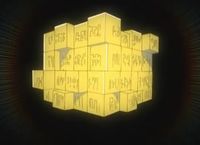Innocence (D.Gray-man)
Innocence is a substance that features in D.Gray-man.
Contents |
History
Innocence (Japanese: イノセンス, Hepburn: Inosensu) was a substance of unknown composition that existed on Earth long ago. Approximately seven thousand years ago, it was harnessed by an ancient civilization that used it to defeat the Noah Family. By wielding the Heart of the Innocence, they were successful in killing the first incarnation of the Millennium Earl. Such was the destructive nature of this battle that it destroyed the ancient civilization with this period being known as the Three Days of Darkness that became equated to the Biblical Great Flood in the Old Testament. From this moment, 109 pieces of Innocences scattered around the world. Prior to their destruction, the ancient civilization prophesized the return of the Millennium Earl and the family of Noah and recorded their words on a cube of Innocence to be found by the next generation. The Cube was later discovered by a group of humans where they learnt of the threat of the Millennium Earl and formed the Black Order to battle him along with his horde of Akuma. In this time, the Earl of the Millennium had awakened where he looked to find and destroy the Heart of Innocence. As a result, he began to hunt those that had acquired Innocence and destroyed the pieces in an attempt to find Heart of Innocence. Unknown to anyone, a sentient Innocence known as Apocryphus operated under a human guise were it looked to protect the Heart.
Around 30 years ago, a particular form of Innocence took the form of a sword named Mugen which came to be wielded by an Exorcist. During a battle against Akuma, he came to be killed with his body and weapon being retrieved by the Black Order. They would come to use his body and the weapon as part of the Second Exorcist Program that was created many years later. This was a program that used the brains of dead exorcists and implant them in new bodies whilst where Mugen was to be wielded by the person. The Innocence was forged into a Japanese sword by Zu-Mei-Chang. However, Yu Kanda could not perfectly synchronize with the Innocence which caused him severe injuries every time.
In China, Suman Dark and two other Exorcists were in China when they encountered Tyki Mikk of the clan of Noah. Battling the superhuman being, they failed in being able to fight him with Suman begging his enemy to spare him. This act led to him betraying his comrades in order to save himself leading to him being left behind by Tyki. He came to be recovered by a group of villagers where they attempted to nurse him back to health which was when he regained consciousness. However, as a result of his actions, Suman betrayed his Innocence causing his body deteriorating into a Fallen One that went on a rampage. A large army of Akuma were dispatched to eliminate the Fallen One with Allen Walker and Lenalee Lee coming upon their mutated comrade who they attempted to save.
During the battle, Tykki Mikk was responsible for shattering Walker's arm and the Innocence within it leaving him badly injured. Afterwards Allen's body was carried to the Asian Branch by For with the innocence following them in the form of mist. Allen trained to get it back. Which he finally achieved, when the innocence took a new form: Crown Clown.
Overview
It could bond with a wide variety of items thus allowing it to take many forms and they each imparted different powers to their users. Exposure to its power was fatal to the Dark Matter of an Akuma and thus was capable of destroying them.
Certain humans could be bonded to Innocence and be equipped as a result with Anti-Akuma Weapons. These select individuals were referred to as Accommodators that manifested the Innocence into different kind of tools.
Anti-Akuma Weapon (対アクマ武器 , Tai Akuma Buki, Literally meaning "Versus Akuma Weapon") were Innocence that had been processed into a usable form.
There were various kinds of Innocence that included:
- Equipment types (装備型そうびタイプ, Sō bi taipu) : these types of Innocence often took the shape of tools and weapons such as swords, boots, clocks and other similar forms. A special forging process was used to turn shard of Innocence of an Accommodator merged with it. Despite being the most common, equipment type Innocence is often the most difficult to control, as the Accommodator must use the Innocence like a tool to make it do what they want, unlike the parasitic type who simply lash out with the part of their body that is their Innocence
- Crystal types (結晶けっしょう型タイプ, Kesshō taipu) : a new form of Innocence that actually was an evolved form of the equipment type. Instead of using an item, crystal type Innocence uses the blood of the Accommodator to form the weapon most suited to their fighting style; because it is made of the Accommodator's blood, as long as the Accommodator has blood in their body, the Innocence could repair itself. Unlike its predecessor, the crystal type does not require that the Accommodator use physical commands and motions; it responds to subconscious cues and thoughts.
- Parasitic types (寄生型きせいタイプ, Ki sei taipu) : a rare form of Innocence that could be fashioned into an Anti-Akuma Weapon. They were typically made from part of the Accommodator's body, such as a limb, with the Innocence actually being infused with the body of the Accommodator. Though it was not part of the tissues that made the hosts human body, it still recognized the limb as being a part of its physical structure. Generally, Exorcists who wielded parasitic type Innocence had a higher synchronization rate when compared to equipment types. A trait among such users was the ability to cleanse their hosts from Akuma poison. Parasitic type Innocence also had the advantage of being able to heal the Accommodator's body should they be infected by the Akuma Blood Virus, though, after excessive exposure to Akuma blood oil, even parasitic type Exorcists would start to display signs of being infected. In addition, these Exorcists required a large amount of food for each meal, as the Innocence drained their energy stores rapidly. The Innocence also puts a great strain on their bodies, shortening their life-spans.
Accommodators varied in the level of their bond with their Innocence with this being referred to as their synchronization rate. Those who reached or exceeded the one hundred percent synchronization limit, or the critical point (臨界者りんかいしゃ, Rin Kaisha) were able to reach new levels of power and could unlock powerful new abilities.
In addition, there was one special type known as the Heart of the Innocence that was the most powerful form of this substance. It was linked to all the Innocence around the world and with it a user could equally destroy the material across the planet simultaneously.
Certain types of Innocence could get their power extended creating a barrier of energy that repelled Akuma. Level 1 Akuma could not pass the barrier though Level 2 were able to pass through it. However, such Akuma could get their personality reversed so long as they were exposed to the effects of this Innocence. When out of the field, the Akuma returned to their personality. The Millennium Earl was shown to hold the power to destroy Innocence by crushing it whereupon it disintegrated into dust.
Individuals that came to be overtaken by their Innocence ran the risk of becoming one of the Fallen Ones (咎落ち, Togaochi). This was a terminal state causing their bodies to mutate into a monstrous state as a result of the exposure. Bonding it with a non-Accommodator resulted in the individual being turned into a Fallen One as only those compatible with it were able to become an Apostle. However, those Accommodators whose synch rate fell below 0% also suffered the risk of turning into a Fallen One. This occurred in cases where an Exorcist lost faith in God with this heretical thoughts leading to their mutation into this form. This could occur if they betrayed their ideals such as watching over their friends and allowing themselves to turn into this corrupted being. The abuse of Innocence in this manner was said to betray the will of God and led to the subject becoming a Fallen One.
Users
- Cube :
- Cross : a parasite type Innocence located on the left arm of Allen Walker that morphed into a hard silver skinned demonic arm. Walker was able to turn it into claw, cannon and sword weapons. It later evolved in Crown Cross where it became more of a body-armor parasitic type, taking the collective form of a cowl and cape, a silver mask and a clawed arm. Not long after this evolution, Allen also gains the ability to use the Sword of Exorcism.
- Mugen : a sword that came to be wielded by Yu Kanda with this being an equipment type Innocence which had been forged and reforged several times into various Japanese swords. Upon crystallization, Mugen's new form is that of a slightly modified katana, with a slightly wider than average blade and a dip along the back, near the hilt. Kanda has two stigmata-like injuries permanently scarred into his forearms, which would allow more blood to flow out to repair Mugen if it were damaged. In this form, Kanda has taken to concealing Mugen in a cloth sleeve and carrying it over his back.
- Dark Boots :
- Time Record :
- Iron Hammer :
- Charity Bell :
- Maker of Eden :
- Noel Organon :
- Heaven Compass :
- Arm of Baptism :
- Judgment :
- Lau Jimin :
- Madness :
- Tsukikami :
- Apocryphos : an independent, sentient Innocence whose purpose was to protect the Heart and had been active in this role for over seven thousand years.
Notes
- Innocence was created Katsura Hoshino where it featured in the setting of the D.Gray-man universe.
In other media
Television
- In D.Gray-man, Innocence appeared in the setting of the anime television series adaptation.
- In D.Gray-man Hallow, Innocence appeared in the setting of the sequel anime television series.
Appearances
- D.Gray-man:
External Links
This article is a stub. You can help Multiversal Omnipedia by expanding it.


